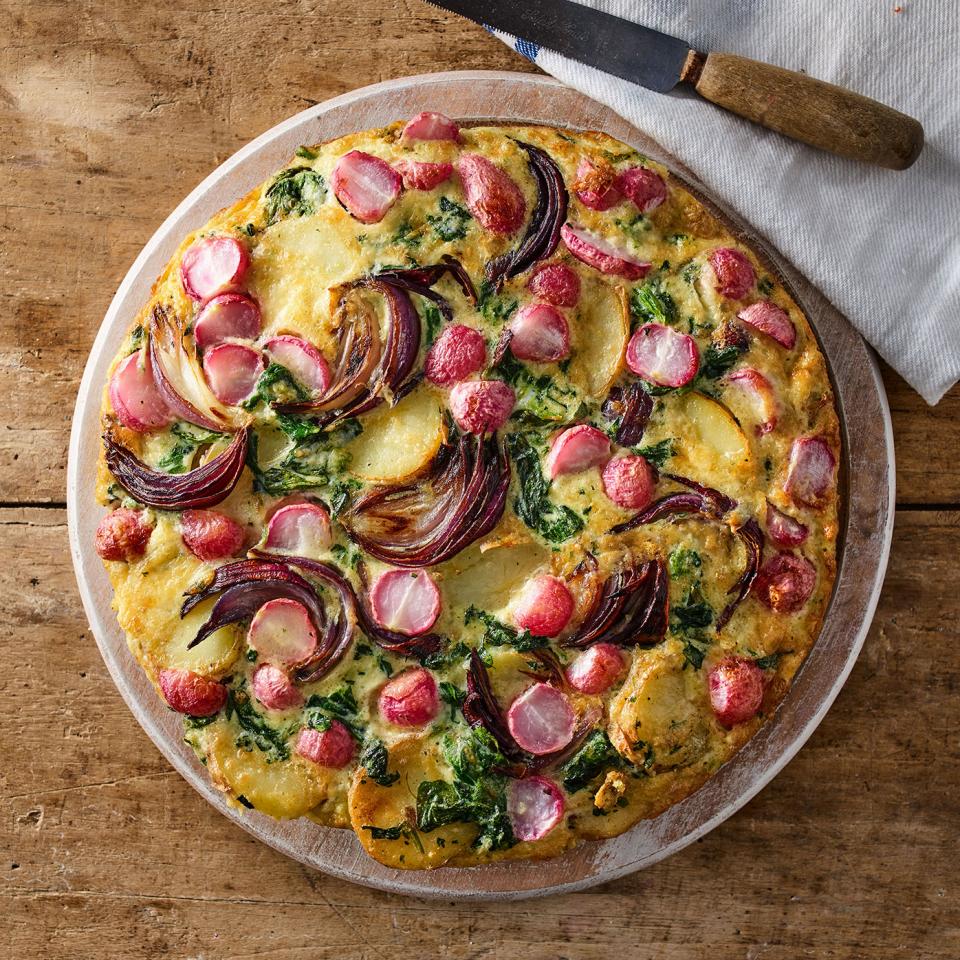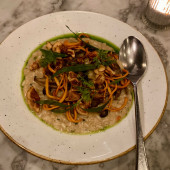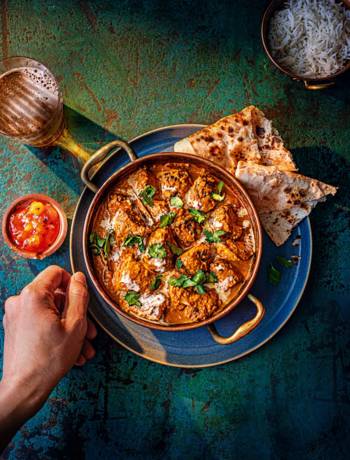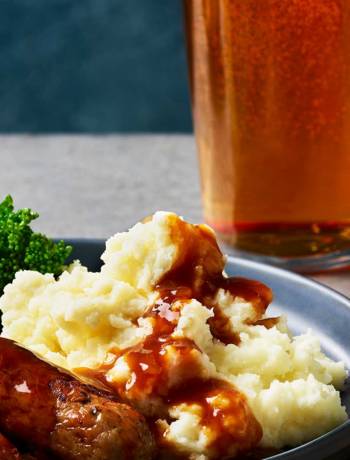Food
The rise of the flexitarian
by Brigid Moss
Love meat but worried about your health? Brigid Moss finds out why more of us are going semi-vegetarian, plus try three of our best flexi recipes.

On Mondays, Wednesdays and Fridays, my whole family eats a meat-free dinner, taking it in turns to find a recipe to make for the others. Homemade pizzas are a favourite, along with veggie curry. Nights when I’ve got zero time, it’s baked potatoes with salads, and a choice of toppings. But on Sundays, we’ll almost always eat meat; it might be roast chicken, lamb rogan josh, spiced meatballs. We are absolutely not vegetarians, but I am consciously trying to help my child and husband eat less meat. In fact, we are classic flexitarians.
If you’ve never heard of the flexitarian diet, you soon will. And if you’re trying to eat more healthily and cut back on meat, you’re already eating the flexi way. Flexitarians – aka flexible vegetarians – are people who eat a vegetarian diet with the occasional addition of meat. ‘A mainly plant-based diet not only helps reduce your risk of obesity, but our evidence shows it helps reduce your cancer risk too,’ says Sarah Toule from the World Cancer Research Fund. ‘Eating more portions of vegetables and fruit, cooking meals from scratch, and including a wide variety of colours on your plate are all good ways to improve your diet.’
‘The concept of being a flexitarian simply means you don’t have stringent rules,’ says Australian dietitian Dr Libby Weaver. ‘It’s about listening to what will best serve your body, health and energy. It means that most of the time you make nutrient-dense food choices, but if you then catch up with your best friend on a Friday night and eat a takeaway, you won’t beat yourself up for making a less nourishing choice.’
The part-time vegetarian concept has been around since the mid-1990s, but really took off with Meat-Free Mondays in 2009, when committed vegetarians Stella, Mary and Paul McCartney wanted to rebrand veggie food as fashionable, do-able and delicious. In 2013, The New York Times food writer Mark Bittman extolled the virtues of eating a mainly plant-based diet in his book VB6: Eat Vegan Before 6:00 To Lose Weight And Restore Your Health For Good (Sphere, £13.99), and the vegan eating movement gained traction stateside. Back in Blighty, clean-eating bloggers such as Deliciously Ella are hellbent on proving that plant-based food can be healthy and tasty, but for those of us who find the idea of giving up a juicy steak miserable, flexitarian living is the perfect solution.

‘My partner and I love meat,’ says teacher Jennifer Lyons, 38. ‘I don’t believe a vegetarian diet can be as delicious as a carnivore one. But the arguments for eating less meat were compelling; I felt bad about meat production and the environmental impact, and I was worried about our health. We read about a flexitarian way of eating in a newspaper, and eating meat only a few days a week felt achievable. That was a year ago, and it’s now a lifestyle we enjoy.’
A 2016 review of research suggests a reduced-meat diet lowers your risk of diabetes and metabolic diseases, and helps keep you at a healthy body weight (a study of 16,000 people suggests your risk of obesity is halved if you eat one or two meat-free meals a week). A 2017 survey by Mintel found that 28% of meat-eating Brits have reduced the amount of meat they eat in the past six months, while research by Kantar revealed that more than a quarter of evening meals are veggie. And a study for last year’s World Vegan Day found that more than half of UK adults already buy some vegan foods and products.
The environmental impact of our diet is partly why we’re eating less meat – producing one pound of meat protein uses 10 times more water than a pound of green protein, says Brian Kateman, author of The Reducetarian Solution: How The Surprisingly Simple Act Of Reducing The Amount Of Meat In Your Diet Can Transform Your Health And The Planet (Tarcher/Putnam, £13.99), but studies suggest health is the main reason we’re making the meat-free switch. ‘Adopting a flexitarian diet increases your consumption of vegetables, and that alone will protect your health,’ says registered nutritionist Rhiannon Lambert, author of Re-Nourish: A Simple Way To Eat (Yellow Kite, £18.99). ‘I still encounter people who eat red meat every day, but processed meat is linked to cancer and can increase your risk of heart disease. Eating less meat, for example swapping mince for lentils, will up your fibre too, which is crucial for gut health. The average Briton gets 17-18g of fibre a day, but they should have 30g a day.’
The beauty of the flexitarian diet is you can adapt it to suit your lifestyle. ‘I always eat vegetarian for breakfast and lunch, then sometimes meat or fish for my evening meal,’ says Saskia Shipman, 50, a marketing executive. ‘I’ll prepare a big mixed salad for lunch, or if I’m eating out, I’ll order a veggie curry or soup and salad. That means I eat my five a day, early in the day, so I can be more relaxed if my dinner isn’t perfect.’
Eating flexi is great for ex-vegetarians because it allows a lot of leeway. ‘It lets you make changes without putting pressure on yourself, so you don’t feel bad if you’re not doing as well on one day as another,’ says Lambert. Perhaps you or someone in your family were one of the 169,000 people who did Veganuary? If so, you probably discovered that you can cook vegan, then add some meat or fish on the side for the omnivores. If you like a challenge but Veganuary feels too much, try going veggie for National Vegetarian Week. Or start simply with Meat-Free Monday.

Being a flexitarian works for families where not everyone is a vegetarian too. Lily Simpson, who created the food delivery company Detox Kitchen, has been veggie for 18 months, but some days cooks meat and fish for her two toddlers, aged one and three. Her staples are veggie curries and rice salad, occasionally supplemented by meat. ‘When I get home, I put the rice on,’ she says. ‘Then I take out whatever veg is in the fridge, cook it with some mild spices, then add toasted seeds, which make everything taste good.’
When you’re eating a mainly vegetarian diet, it’s important to get enough protein. Meat and fish contain complete proteins, which means they have all the essential amino acids, but apart from exceptions such as quinoa, most vegetarian sources don’t. To get all your aminos, try to combine foods, advises Lambert. For example: oats and nuts, peanut butter on wholegrain bread, rice and beans. If you’re eating mainly veggie, you might come up short in these nutrients: vitamin B12 (a good veggie source is nutritional yeast or Marmite), iron (find it in lentils), iodine (seaweeds are a good source), vitamin D (found in some mushrooms and fortified plant milks) and omega 3 (try nuts, seeds and soya beans). For more information, see the factsheets at vegsoc.org.
But the most important guideline? Enjoy a variety of vegetables. Simpson says your plate should look like a rainbow. ‘Look at getting more in your diet rather than taking anything out,’ says Lambert. She suggests you try to cook a new vegetable each week and include veg in every meal. Rather than the same old porridge every day, eat a savoury breakfast: avocado and egg on toast, pepper frittata or grilled tomatoes and mushrooms. Instead of salads with chicken for lunch, Lambert suggests falafel, chickpeas, lentils or beans. And for supper, a veggie curry. ‘Try to cook something new,’ she says, ‘there are plenty of quick veggie dishes. Remember, there are no strict rules. The great thing about flexitarian living is that it can fit anyone.'
Quick and easy veggie swaps
Want to turn your usual meat recipe into a vegetarian option? Here’s how:
- To make bolognese, lasagne, shepherd’s pie or chilli, swap mince for lentils, sliced mushrooms or Quorn mince (or a combination of all three).
- In a cooked breakfast, swap bacon for grilled halloumi cheese or meat-free bacon.
- Portobello mushrooms, cauliflower steak or aubergine slices can replace chops or steak.
- In stir-fries and curries, swap chicken, pork and beef for chickpeas, tofu or cashew nuts.












